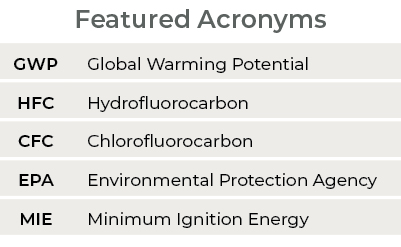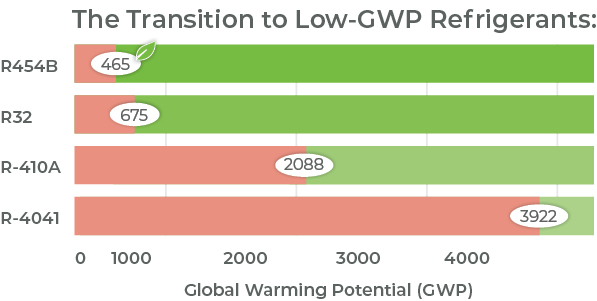

Featured Acronyms
- GWP
- Global Warming Potential
- HFC
- Hydrofluorocarbon
- CFC
- Chlorofluorocarbon
- MIE
- Minimum Ignition Energy
- EPA
- Environmental Protection Agency
Refrigerants are essential components of modern heating, ventilation, and air conditioning systems. They play a crucial role in transferring heat from one area to another. However, the type of refrigerant used can have a significant impact on the environment, which is why the heating, air conditioning, and refrigeration (HVACR) industry is currently undergoing a transition to low-global warming potential (GWP) refrigerants.
Understanding Refrigerants
Refrigerants are chemical cooling agents used in HVAC systems to transfer heat energy. They flow through various components of the system, such as the condenser, compressor, evaporator, and expansion valve. During the heat exchange cycle, refrigerants change states from liquid to gas and back, absorbing heat from the refrigerated space and transferring it outside to cool the area. There are two main categories of refrigerants: Hydrofluorocarbons (HFCs) and Chlorofluorocarbons (CFCs). HFCs are currently the most commonly used, while CFCs have been phased out due to their ozone-depleting effects.
The Transition to Low-GWP Refrigerants
The HVACR industry is undergoing a significant shift as HFCs like R-410A (A1) and R-404A (A1) are being phased out in favor of new, low-global warming potential A2L refrigerants like R-32 and R-454B. These transitions are crucial to reducing greenhouse gas emissions and mitigating the effects of climate change. The goal is to use refrigerants with low GWPs to achieve a more sustainable and environmentally friendly future.

One low-GWP refrigerant, R-454B, is gaining popularity due to its environmental benefits. Compared to R-410A, R-454B offers a 76% decrease in global warming potential and is 34% lower than R-32. HVAC units using R-454B can achieve higher seasonal efficiency, reducing operating costs and environmental impact. R-454B represents a balanced choice for both customers and the environment.

The phase-out of high-GWP refrigerants is underway, with the Environmental Protection Agency implementing a phasedown plan for R-410A. Starting on January 1, 2022, there was a 10% reduction in production and importation, followed by a 40% reduction taking place on January 1, 2024, and further reductions in subsequent years. The aim is to reduce R-410A production and importation by 85% over 15 years. EPA is proposing that the production of new air conditioning and heat pumps containing R-410A be stopped as of January 1, 2025.
What to Expect
As R-410A phases down, the industry is looking to alternative refrigerants with low GWPs, such as propane (R-290), hydrocarbons, and CO2. However, these options come with their own set of challenges. Propane and hydrocarbons are flammable, and CO2 is not practical for most residential applications. This has led to the development and adoption of A2L refrigerants to strike a balance between practicality and flammability. While some of the new refrigerants that are classified as A2L, such as R-454B, are mildly flammable, they have a higher minimum ignition energy (MIE) and burn more slowly, making them safer options. While A1 refrigerants, such as R-410A, are less flammable, they are not as effective in environmental protection, which is why an A2L class refrigerant combines the best of both worlds with low-GWP and mild flammability.
The transition to low-GWP refrigerants is a crucial step in reducing the environmental impact of HVAC systems. While there are challenges and concerns related to flammability, the industry is making strides in ensuring safety and efficiency. The phasedown of high-GWP refrigerants is well underway, with increasing emphasis on using sustainable and environmentally friendly alternatives. As this transition unfolds, it's important to stay informed about local codes and standards, as the adoption of low-GWP refrigerants may vary based on your location.
If you have questions about what this transition means for your home and HVAC system, just give us a call to schedule a free over-the-phone evaluation. Our technicians can help you find a solution tailored to your home. Don't forget to explore available tax credits, manufacturer rebates, or financing to help with the cost of a new system for your home. Call 812-339-9114 or schedule online today!



